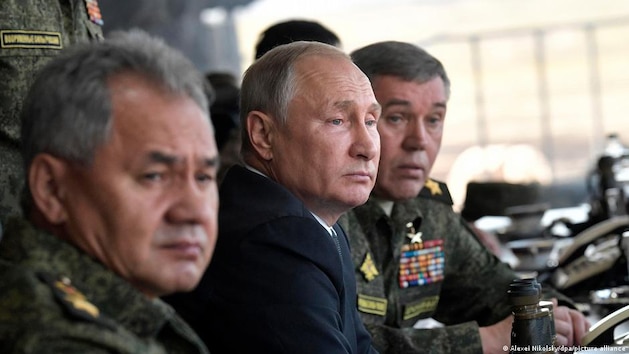A reform announced by the Kremlin provides for the reinforcement of the Russian army by 350,000 men. How is so much new military personnel supposed to be recruited, so much new equipment financed? Experts estimate that the targets are unrealistic for a number of reasons.
Russia wants to increase its army by another 350,000 soldiers to 1.5 million men. In justification, Russian Defense Minister Sergei Shoigu recently told his deputies that the “military security of the state” and the “new subjects”, as he describes the areas of Ukraine illegally annexed by Russia, but also the security of “critical facilities” in the country can only be guaranteed “if the most important structural components of the armed forces are strengthened”.
According to him, a reform starting this year should be completed in 2026. As part of this, the former military districts of Moscow and Leningrad (now St. Petersburg) are to be restored, new troop formations are to be created in the Russian-occupied areas of Ukraine, and twelve new mobile divisions are to be created.
In addition, a new corps is to be formed in Karelia. It is to include three motorized rifle divisions as part of the ground forces and two divisions of airborne troops. “The corps in Karelia is a response to NATO expansion,” says Ukrainian-born Israeli military expert David Sharp. The Russian region of Karelia borders Finland, which, like Sweden, has applied for NATO membership.
According to Sharp, Russia’s war of aggression against Ukraine has shown that the Russian army is not numerically capable of fulfilling its mission of occupying Ukraine. In addition to increasing the army, Moscow also wants to change the organization of the troops. “The reform aims to accelerate the transition from brigades to divisions, giving units more autonomy. The changes are aimed at long-term goals, less at correcting the current situation on the front,” says the expert.
However, the most important point of the announced reform – the increase in the army by 350,000 people – raises questions among observers. With whom should the new units be staffed?
In Russia today, all men between the ages of 18 and 27 are conscripted. About 270,000 recruits are drafted for a year’s service in the spring or fall each year, which is just part of this age group. So far, many men have been able to evade recruitment through university studies or through bribery.
The draft age is to be raised from the current 18 to 27 years to 21 to 30 years. “It is part of this reform. 18-year-old recruits are still ‘kids’ and hardly fit to fight, whereas 21- to 30-year-olds are physically stronger and already have training that the army can use,” explains David Sharp. He assumes that in the future significantly more conscripts will actually be called up.
In a first step next spring, however, only the upper limit is to be raised to 30 years. The lower limit is to be raised at an unspecified later date. That would expand the pool of those subject to conscription to almost two million men.
Meanwhile, discussions about further mobilization in Russia continue, especially since the Kremlin recently confirmed that the presidential decree ordering “partial mobilization” in connection with the war against Ukraine last September is still valid.
“If we talk about the course of this war, then the announced reform can only be implemented with additional mobilization. Hundreds of thousands must be drafted to bring the army up to 1.5 million men. The number of soldiers is the only trump card that Russia still has,” says Sharp.
The Ukrainian expert Andriy Ryschenko, once deputy chief of staff of his country’s navy, believes that further mobilization in Russia will not help. According to him, the Russian General Staff is still busy distributing the conscripts from the first wave of conscription. “New men will just sit around and do nothing,” says the expert. According to him, the Kremlin has so far tried unsuccessfully to compensate for the previous losses in the war with the last mobilization. According to Ryschenko, the reform will also not bring anything in the short term: “Since the beginning of the war, Russia has suffered very heavy losses that should be compensated. But new soldiers can only be expected at the front before next winter.”
The planned increase in the Russian army is the second during the war against Ukraine. In August 2022, President Vladimir Putin had increased the maximum strength by 140,000 men. Together with the additional 350,000 now planned, this would mean almost half a million new soldiers who would have to be equipped with weapons and uniforms, which means an enormous burden on the national budget.
Given the drop in oil and gas revenues, can Moscow even afford all this? “This reform requires a lot of resources, not just money and manpower. Equipment and infrastructure are needed for these 350,000 men. In addition, specialists who instruct recruits must be trained,” says David Sharp. He does not rule out that many newly created units exist only on paper or will not receive military equipment. “The reform seems unrealistic on a significant part of what it promises,” Sharp said.
According to Andriy Ryschenko, it costs around $80,000 to equip a soldier with everything he needs. In view of the high costs and the decline in revenue from the state budget, he too doubts that the reform can be implemented. He also points out that Russia is also dependent on foreign components for military equipment. And such a measure is certainly not popular with the people either: “Ultimately, many Russians are not willing to go to war,” says Ryschenko.
Adaptation from the Russian: Markian Ostapchuk
Author: Kirill Buketov
The original of this article “Putin’s plan for a giga-army threatens to fail for several reasons” comes from Deutsche Welle.















